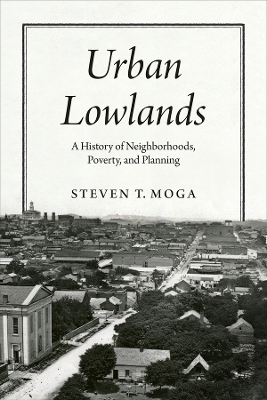
Urban Lowlands
A History of Neighborhoods, Poverty, and Planning
Seiten
2024
University of Chicago Press (Verlag)
978-0-226-83333-0 (ISBN)
University of Chicago Press (Verlag)
978-0-226-83333-0 (ISBN)
Interrogates the connections between a city’s physical landscape and the poverty and social problems that are often concentrated at its literal lowest points.
In Urban Lowlands, Steven T. Moga looks closely at the Harlem Flats in New York City, Black Bottom in Nashville, Swede Hollow in Saint Paul, and the Flats in Los Angeles, to interrogate the connections between a city’s actual landscape and the poverty and social problems that are often concentrated at its literal lowest points. Taking an interdisciplinary perspective on the history of US urban development from the nineteenth to the mid-twentieth century, Moga reveals patterns of inequitable land use, economic dispossession, and social discrimination against immigrants and minorities. In attending to the landscapes of neighborhoods typically considered slums, Moga shows how physical and policy-driven containment has shaped the lives of the urban poor, while wealth and access to resources have been historically concentrated in elevated areas—truly “the heights.” Moga’s innovative framework expands our understanding of how planning and economic segregation alike have molded the American city.
In Urban Lowlands, Steven T. Moga looks closely at the Harlem Flats in New York City, Black Bottom in Nashville, Swede Hollow in Saint Paul, and the Flats in Los Angeles, to interrogate the connections between a city’s actual landscape and the poverty and social problems that are often concentrated at its literal lowest points. Taking an interdisciplinary perspective on the history of US urban development from the nineteenth to the mid-twentieth century, Moga reveals patterns of inequitable land use, economic dispossession, and social discrimination against immigrants and minorities. In attending to the landscapes of neighborhoods typically considered slums, Moga shows how physical and policy-driven containment has shaped the lives of the urban poor, while wealth and access to resources have been historically concentrated in elevated areas—truly “the heights.” Moga’s innovative framework expands our understanding of how planning and economic segregation alike have molded the American city.
Steven T. Moga is associate professor of landscape studies at Smith College.
Introduction: The Low Wards
1 From Bottomlands to Bottom Neighborhoods
2 Harlem Flats New York, New York
3 Black Bottom Nashville, Tennessee
4 Swede Hollow Saint Paul, Minnesota
5 The FlatsLos Angeles, California6 Landscapes of Poverty and Power
Epilogue: Lowland Legacies
Acknowledgments
Notes
Index
| Erscheinungsdatum | 16.03.2024 |
|---|---|
| Reihe/Serie | Historical Studies of Urban America |
| Zusatzinfo | 39 halftones |
| Sprache | englisch |
| Maße | 152 x 229 mm |
| Gewicht | 313 g |
| Themenwelt | Geisteswissenschaften ► Geschichte ► Regional- / Ländergeschichte |
| Naturwissenschaften ► Geowissenschaften ► Geografie / Kartografie | |
| Sozialwissenschaften ► Soziologie | |
| ISBN-10 | 0-226-83333-X / 022683333X |
| ISBN-13 | 978-0-226-83333-0 / 9780226833330 |
| Zustand | Neuware |
| Haben Sie eine Frage zum Produkt? |
Mehr entdecken
aus dem Bereich
aus dem Bereich
Erinnerungen
Buch | Softcover (2024)
Pantheon (Verlag)
CHF 22,40


